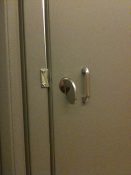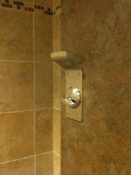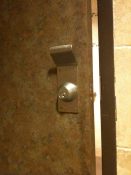One easily overlooked requirement in both ICC A117.1 and the 2010 ADA is the stall door hardware language. Full compliance with these requirements makes life so much easier for folks with mobility disabilities.
Door pulls are required on BOTH sides of the wheelchair and ambulatory accessible toilet compartment door(s) and the door must be self-closing. The self-closing feature assists someone with limited reach to get the door to close behind them and the pull on both sides allows someone with reduced grip to hold the door closed while engaging the latch. The most common stall door hardware style is a small knob on a slide bar that requires tight pinching and gripping to pull closed and latch (not allowable under Section 404.2 of either code/law.)
- Accessible stall door hardware, interior with pull handle
- Accessible Stall door hardware, interior latch
- Accessible stall door hardware, stall exterior
2003 ICC A117.1 Section 604.8.3 (wheelchair accessible compartment doors) and Section 604.9 (ambulatory compartment doors) and 2010 ADA Section 604.8.1.2 and 604.9 all require that “The door shall be self-closing. A door pull complying with Section 404.2 shall be place in both sides of the door near the latch.”
I’m including three images of accessible options for stall door hardware. The first is the most common, with a traditional “D” shaped pull and a paddle handle latch. The second and third were an innovative set (both sides shown) I found on my travels in the Rockies recently. This would be able to be used by someone who just dropped their wrist into the gap, no need to use fingers! Note that the exterior image shows that the door rests about two or three inches from closed when not latched. That would be easy to reach and engage.
(Thanks for overlooking the grainy photos. I’m waiting for the next generation of iPhone with a spiffier camera!)



The latch on the second example might be a little difficult for someone with limited dexterity, but I agree the design is spiffy.